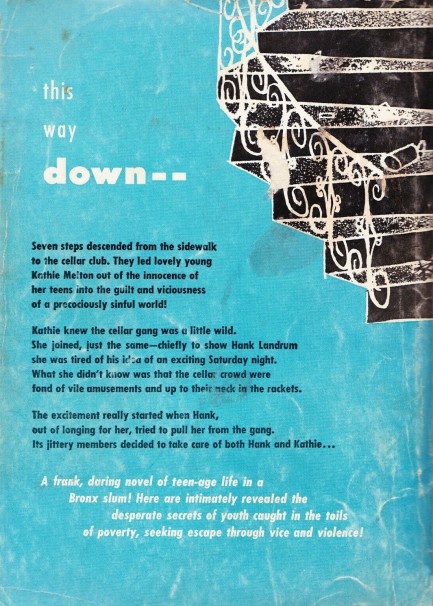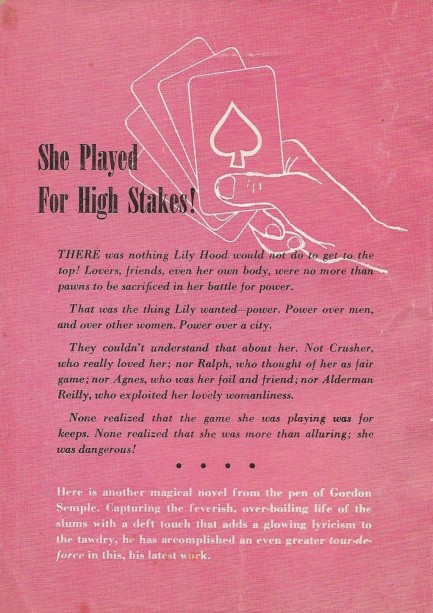 Listen, baby, I steal, extort, and sell drugs. You had to expect me to have unconventional views on relationships. 
This photo cover for David Williams' juvie delinquent novel Basement Gang is one we've admired for years. Enticed by its colors and out-of-focus foreground figure, and finally finding it at a good price, we snagged a copy. Originally published in 1953 by Complete Novel Magazine, with the above edition coming the same year from Intimate Novels, it's a cautionary tale told in detailed if clinical style following Bronx born Kathie Melton, who out of boredom dumps her solid boyfriend Hank, is lured through the forbidden doorway of the local underground club Comets, and is soon drunk, drugged, and de-virginized to the limits of her ripe young body. Kathie is willing to repeatedly indulge in all these activities, but she hates that the hepcats with whom she's hooked up are criminals. Hey, sitting around being disaffected all day requires some sort of funding. Kathie rolls with the life of petty crime, however when a romantic rival sets her up to be beaten and (almost) raped by a dangerous thug, the square life starts to look good again. But leaving Comets and co. isn't simple. As juvenile delinquent fiction goes, Williams did a good job with this one, even if his prose doesn't invite deep emotional involvement. We think it was his only novel, but just in case we'll keep our eyes open for more.
 The city is fine. It's the men that are in disrepair. 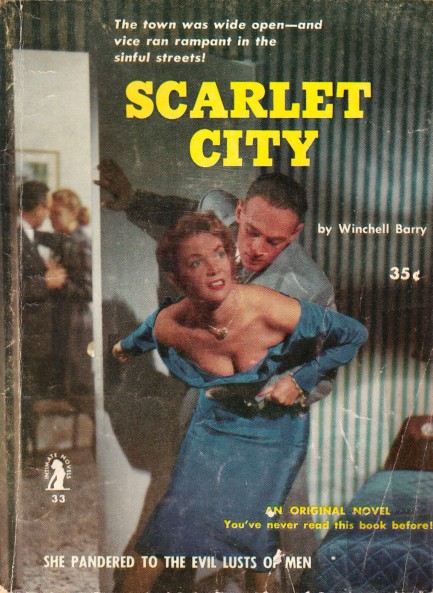
You may have noticed we're looking at photo covers a bit more lately. Here's one for Winchell Barry's Scarlet City. The art here is interestingly tinted, and the moment of struggle depicted while indifferent people occupy the adjacent room says plenty. We showed you the Beacon Signal cover a couple of years ago, but the book was actually first published in the above form by Intimate Novels in 1953. The line at the bottom, “She pandered to the lusts of evil men,” pretty much sums up the story, as the main character Lora tries to sleep her way to the top. If you want to know more feel free to check here.
 Hold it! That's good. Now give me shock and dismay. Excellent! Now give me, “I-wonder-if-he-shot-me-in-that-sixty-nine.” 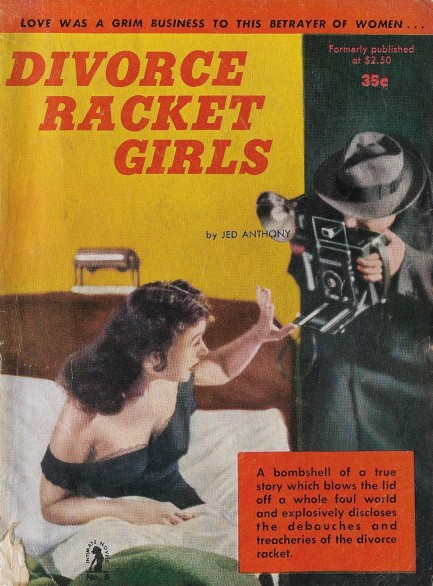
Why buy sleaze digests? Because some of them are very good. Jed Anthony's Divorce Racket Girls is categorized as a sleazer, but it's really a hard-boiled drama, telling the story of Frank Rodie, a New York City detective who specializes in gathering evidence for divorce actions. This basically involves catching his rich clients' spouses in bed. If he can do that by following them around, fine. If he needs to seduce them himself, well, even better. But there may be a price to pay for sticking his private dick into the lives of NYC's one percent. The book is extremely well written in parts, bringing to mind contemporary writers like James Ellroy. Have a read:
At Healy's later. Still about ten G's left. What to do with it? Tony Spinalli invites him to a big poker session. The weisenheimers are laying for the rolls of two fall guys from Alabama. On the third night of the limit game he is wiped out. Stickpin gone. New car gone. He signs a note for the three grand held in trust for Judith. Two nights later learns that the Alabama suckers had been sharpshooters in league with Tony and the others. In the gambling world there's no comeback. A lobster falls easiest. Well, easy come, easy go.
Another snippet:
Frank Rodie, undercover man. From city to city, all over the map. White light and red light and Bible sectors. Eyes roving, ears cocked, smiling his disarming way into people's confidences. Feeling his path along the sundry strata of the underworld, acquiring every trick of the game, posing as a “dip,” a “sheet-writer,” a “yegg.” A good detective must be a good thief. Dizzying whirl, the people and the places rotating about young Rodie. Cabarets, the racetrack, the pipe and coke in hip-joints, roulette houses, country clubs. The world bristling everywhere.
One more:
Always when the case involved a dame, he was assigned to rope her. Irresistible Rodie, making passes at drugstore blondes and exotic brunettes, dumb clucks and wise babies, the perfumed and the smelly, ga-ga gushers and junoesque heavies, joy-ladies and cherries—women of every complexion, nationality, and virtue. Look at them fall for the Big-Boy, his contagious grin, his busy hands.
So yeah, Jed Anthony has a strong voice and talent, and Divorce Racket Girls is a good book, even if it has an ending that values irony over credibility. We've seen it on sale for fifty dollars, but we've also seen it for five because nobody seems certain how to price it. Sleaze digests are usually expensive, especially if they have covers painted by digest specialists like George Gross or Rudy Nappi. But don't let magical art make you think the prose is magic too. Often the opposite is true. The photo front on this book isn't scintillating, but the writing shines. After we finished it we looked for more from Anthony and found nothing. Too bad. The man had style. 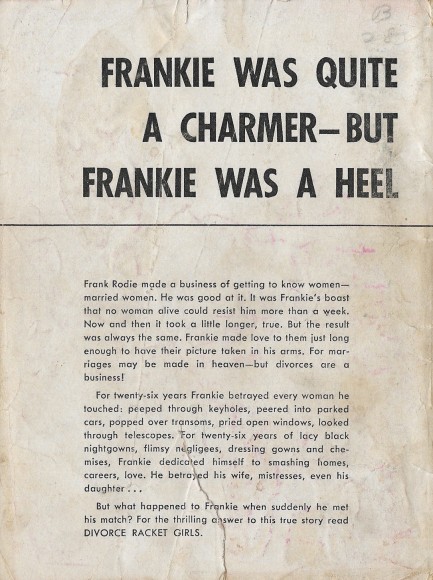
 A nipple scope? Alright, blouse and bra coming off. I thought it was a stethoscope, but I'm no doctor. 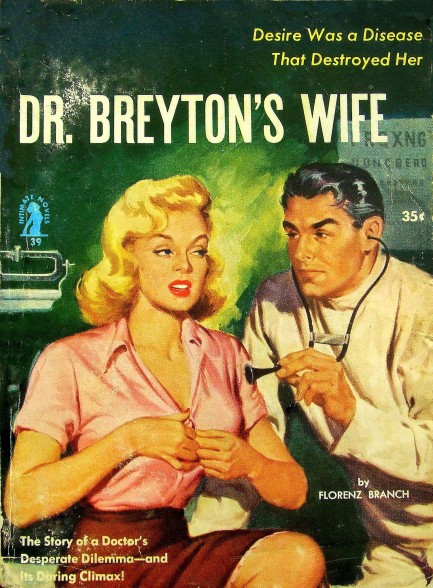
The doctor sleaze keeps on coming. Here's another to add to our vast collection—Dr. Breyton's Wife by Florenz Branch, aka Florence Stonebraker, for Intimate Novels, 1953. You see this around the internet a lot, but it originally came from Sleazy Digest Books. We haven't read it, but we own two of Branch's other novels, which means you will hear from her a little later.
 Why do you always have to squeeze so hard? Once in a while we could just cuddle, you know. 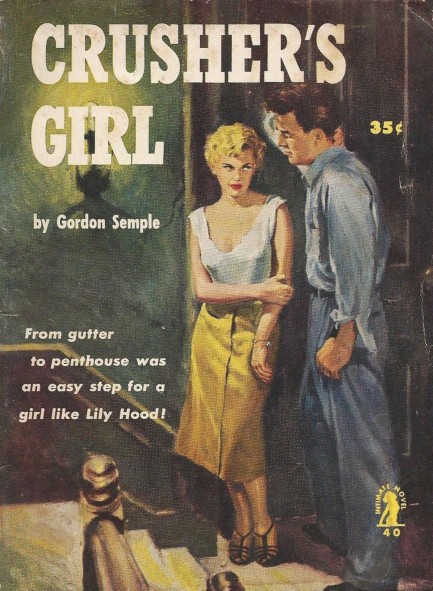
We just shared a paperback from Gordon Semple, aka William Neubauer, last week, but why not keep things Semple? Above you see Crusher's Girl, 1953, from Intimate Novels, with uncredited cover art. The girl referenced has the great name Lily Hood, which tells you right away she's the archetypal antiheroine of limited means, great determination, and flexible ethics trying to hustle her way out of the slums. We can't tell you more because we haven't read it. That's what happens when you expend almost all your available energy pulling off a massive move. On the plus side, our new city is pretty nice so far, and offers plenty of outdoor reading spaces. We'll have detailed write-ups on our book postings soon.
 I dyed my hair red months ago, but the old nickname stuck. Folks around these parts ain't fond of change. 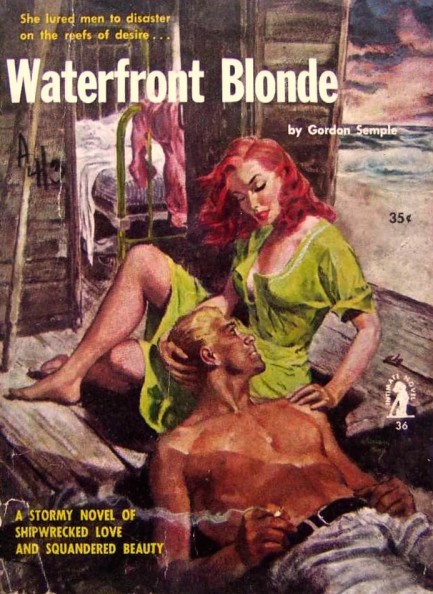
The above cover for Gordon Semple's 1953 novel Waterfront Blonde features Warren King art, possibly repurposed from the front he painted for Forbidden Fruit, below (and previously seen in this post). We say possibly only because we don't know which cover came first. Maybe Forbidden Fruit was repurposed from Waterfront Blonde. Both books are copyrighted 1953. In our non-professional opinions, we think Waterfront Blonde was second. There are several reasons why, any of which could be picked apart by someone with the opposite view. For example, if Waterfront Blonde came first, why not make the female figure's hair blonde? On the other hand, if it came second, that means King changed the hair color of the male figure, but didn't bother doing the same with the woman. Either way it's odd, but the main thing to note here is how the art has been recycled, which occurred often during the mid-century heyday of paperback fiction. We'll surely have more examples down the line. 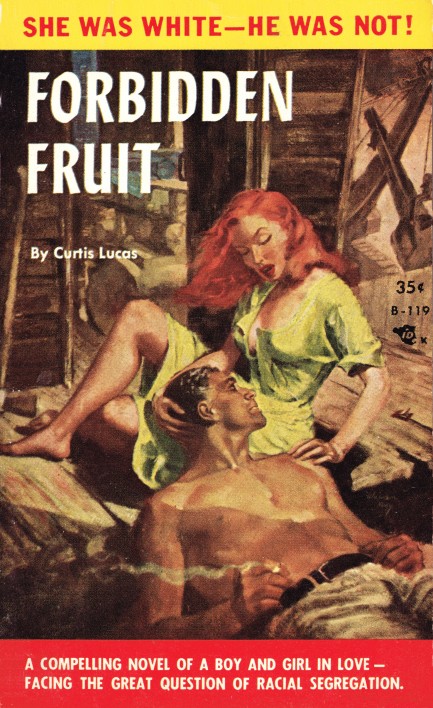
 When you girls invited me here I think I heard a word other than “sax.” 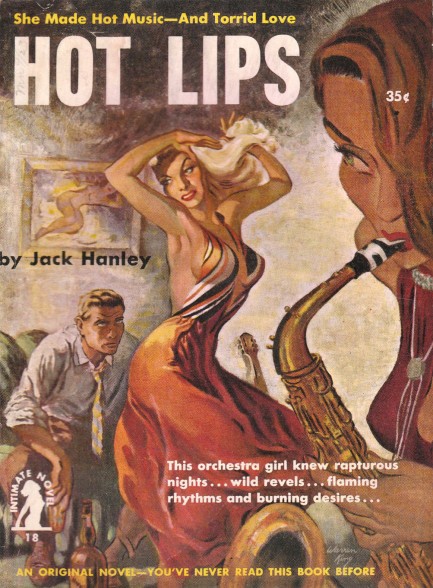
This amazing cover was painted by Warren King. We'd give just about anything for a lithograph of this. Hot Lips is about an “all-girl" orchestra called the Musical Queens and the things they do when boys aren't around. Which we can understand. Just look at the male figure here, whose name is Pete. What exactly does he bring to this party? A sense of brooding entitlement? A vague homophobic hostility? The latter, for sure, since he lost his wife to another woman and is dismayed to find himself in sexual competition with the band's man-hating sax player. Why does saxy Mona hate men? Because her husband turned out to be a drag queen. But all Pete has to do is wait a bit, because while the wholesome, virginal object of desire in this, Althea, may be tempted by wild musical lesbians, such assignations are never permanent in mid-century genre fiction. It's heteronormativity or death—literally, sometimes. Put Hot Lips in the lesbians-are-bad bin with a pile of other novels from the period. We'll keep an eye out for more cover work from Warren King, because this is just great. It's copyright 1952.
 Eew. Please tell me you washed that hand after you were out there in that nasty gutter. 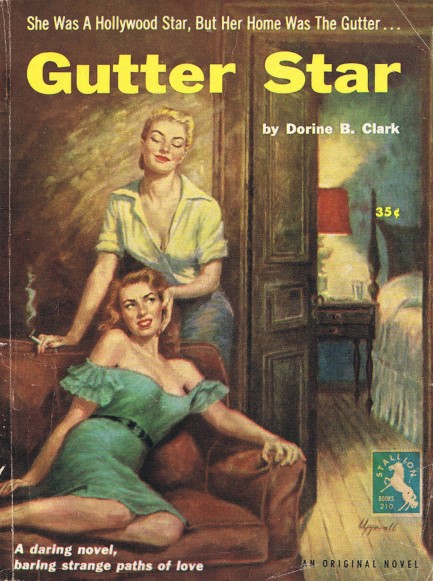 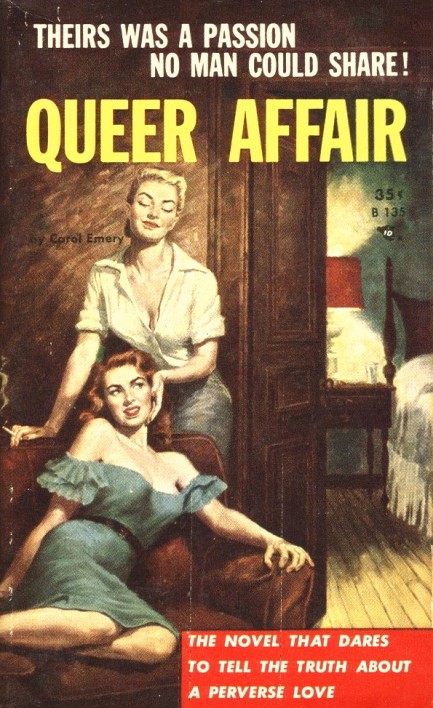
Above, an awesome cover for Gutter Star, Intimate Novel #52, written by Dorine B. Clark and published in 1954. The painting is by Frank Uppwall, and it was reused in 1957 by Beacon for Carol Emery's lesbian novel Queer Affair.
|
 |

The headlines that mattered yesteryear.
2003—Hope Dies
Film legend Bob Hope dies of pneumonia two months after celebrating his 100th birthday. 1945—Churchill Given the Sack
In spite of admiring Winston Churchill as a great wartime leader, Britons elect
Clement Attlee the nation's new prime minister in a sweeping victory for the Labour Party over the Conservatives. 1952—Evita Peron Dies
Eva Duarte de Peron, aka Evita, wife of the president of the Argentine Republic, dies from cancer at age 33. Evita had brought the working classes into a position of political power never witnessed before, but was hated by the nation's powerful military class. She is lain to rest in Milan, Italy in a secret grave under a nun's name, but is eventually returned to Argentina for reburial beside her husband in 1974. 1943—Mussolini Calls It Quits
Italian dictator Benito Mussolini steps down as head of the armed forces and the government. It soon becomes clear that Il Duce did not relinquish power voluntarily, but was forced to resign after former Fascist colleagues turned against him. He is later installed by Germany as leader of the Italian Social Republic in the north of the country, but is killed by partisans in 1945.
|

|
|

It's easy. We have an uploader that makes it a snap. Use it to submit your art, text, header, and subhead. Your post can be funny, serious, or anything in between, as long as it's vintage pulp. You'll get a byline and experience the fleeting pride of free authorship. We'll edit your post for typos, but the rest is up to you. Click here to give us your best shot.

|
|


